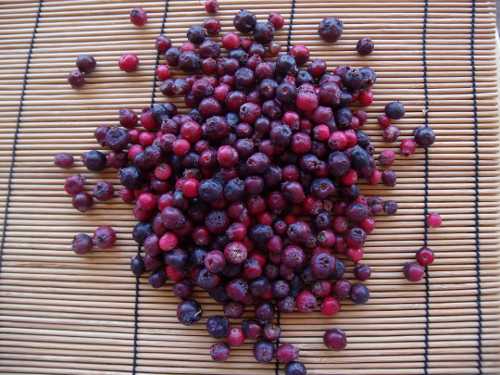- Lake County News Reports
- Posted On
The Veggie Girl: Sassy Saskatoon berries

I was delighted to have my level of fruit and veggie awareness raised through two unexpected finds at last week’s farmers’ market.
One of them, a powerfully nutritious but largely unknown veggie, will be the subject of next week’s column. This week is devoted to the other, the bright, sassy Saskatoon berry.
When I happened upon these little berries, their size, shape and jewel-like red-purple-blue coloration reminded me of a cross between huckleberries and cranberries. Nibbling on a few revealed a sweet-tart flavor, furthering this thought.
Research upon my return from the market showed that they’re related instead to an entirely different fruit, the apple. We call them a berry, but botanically, like the apple, they’re a pome.
Saskatoon berries, more commonly called saskatoons, are native throughout much of Canada, Alaska and the north central United States.
They’re considered “super fruits” because of their high level of health-promoting antioxidants, which have anti-cancer and anti-aging effects.
Antioxidants also contribute against cardiovascular and inflammatory diseases and act as a protective guard to our immune systems.
Since it’s to our benefit to consume antioxidant-rich foods, we should keep our eye on the Saskatoon berry, which has the highest ORAC (oxygen radical absorbance capacity) value of any fruit, a method used to determine antioxidant activity.
In addition to its powerful stores of antioxidants, saskatoons are an excellent source of manganese, magnesium, iron, potassium and copper, as well as being rich in vitamins A and C. As to iron, they contain three times the amount as in the same weight of raisins.
They were an important food to indigenous peoples in North America, who – not surprisingly – also used other parts of the plant for medicinal purposes. The wood of the saskatoon bush is weighty and flexible, so was used in the production of arrows, tools, basket frames and cross pieces of canoes.
Early pioneers that settled throughout its native range relied on the saskatoon as a food staple.
Until recently, saskatoon berries grew only in the wild and were foraged, rather than harvested; however, commercially viable methods of farming them now exist.
It was less than 20 years ago that the first orchards were planted, and most of these exist in Canada, where demand far exceeds supply.
In the U.S., these berries are more commonly called serviceberries, June berries, or shadberries. “Saskatoon” derives from their longer but similar-sounding name in the Cree language. The city of Saskatoon in Saskatchewan, Canada is named for the berry.
They taste a bit like blueberries, but with a meatier texture. They’re described as having a nutty, almond-like flavor, and using almond extract in recipes that include them enhances this.
Saskatoons may be frozen or dried, as well as used fresh.
The culinary uses for saskatoons are similar to those of berries; they’re made into jams (quite possibly their most popular use), baked into pies, tarts and clafoutis, added to muffins, breads and scones, and sauces and relishes are made with them.
I saw a creative recipe at www.PlanetGreen.com utilizing saskatoons in a red wine sauce for roast pork.
I decided to make a fragrant sauce with them for serving over yogurt, which I’ve shared below. The berries held their shape well, making a nice contrasting texture to the smoothness of the yogurt, and the sweetness of the sauce was a perfect compliment to the yogurt’s tartness.
If you plan to use the sauce over a sweet dessert such as ice cream or cheesecake, I’d recommend reducing the sugar in the recipe by about half.
I’m glad to have made the acquaintance of these happy berries. I feel I have a new culinary friend. I hope you’ll enjoy them, too.
Saskatoon berry sauce
2 cups fresh saskatoon berries
¼ cup water
¼ cup sugar
1 cinnamon stick
½ vanilla bean
2 slices lemon
4 wide swaths of orange zest
Simmer all ingredients together in a saucepan until berries are flavored through and sauce is warmed, about 10 to 15 minutes.
Note that the sauce will be runny. If a thicker sauce is wanted, thicken with a little cornstarch or arrowroot powder. A thicker (less sweet) sauce would be a marvelous topping for cheesecake.
Store sauce well-covered in fridge.
Recipe by Esther Oertel.
Esther Oertel, the “Veggie Girl,” is a culinary coach and educator and is passionate about local produce. Oertel teaches culinary classes at Chic Le Chef in Hidden Valley Lake, Calif., and The Kitchen Gallery in Lakeport, Calif., and gives private cooking lessons. She welcomes your questions and comments; e-mail her at This email address is being protected from spambots. You need JavaScript enabled to view it..
Follow Lake County News on Twitter at http://twitter.com/LakeCoNews, on Tumblr at www.lakeconews.tumblr.com, on Facebook athttp://www.facebook.com/pages/Lake-County-News/143156775604?ref=mf and on YouTube athttp://www.youtube.com/user/LakeCoNews.
















